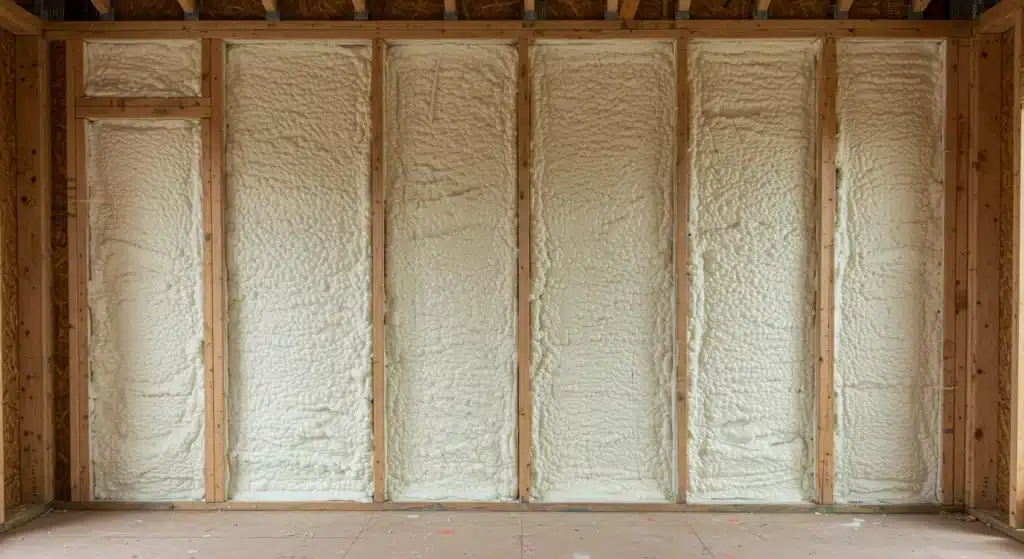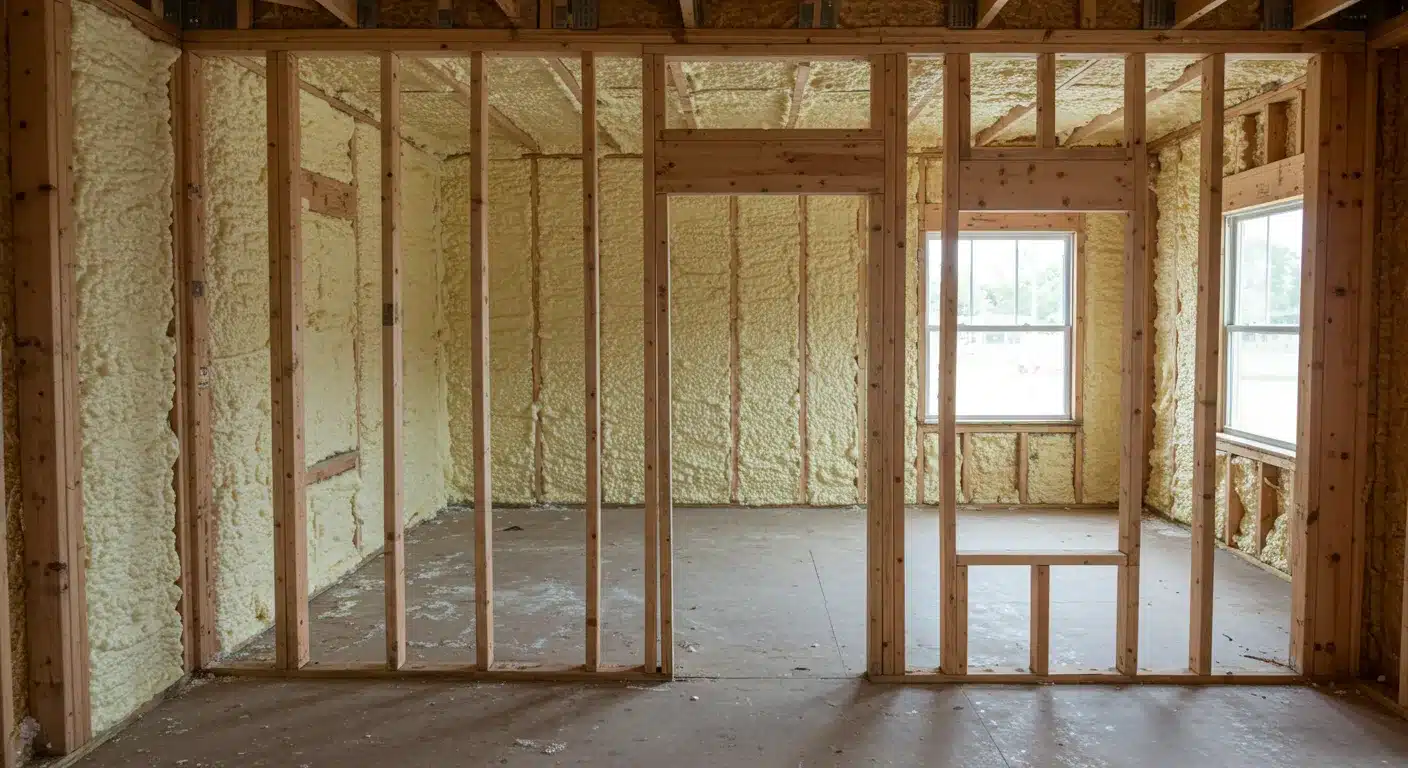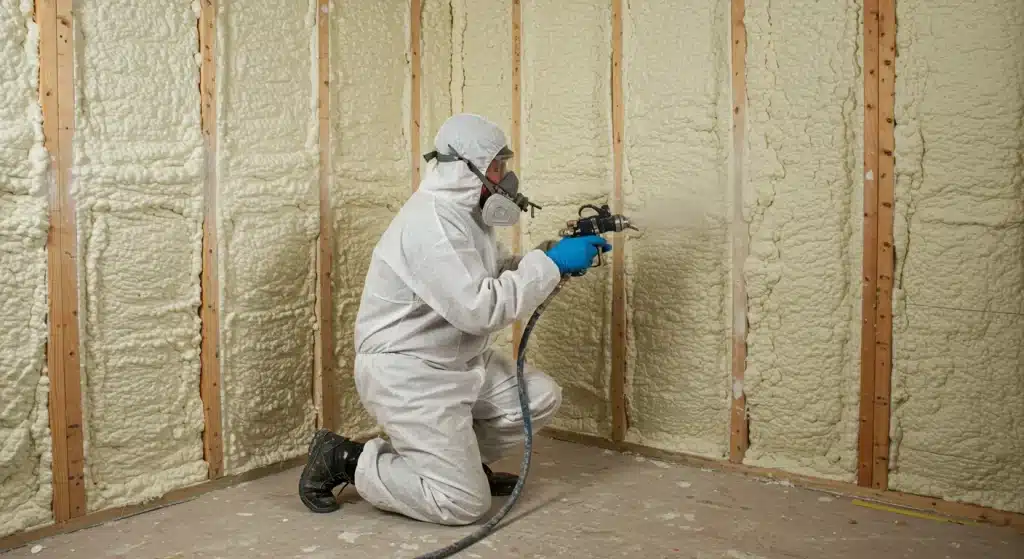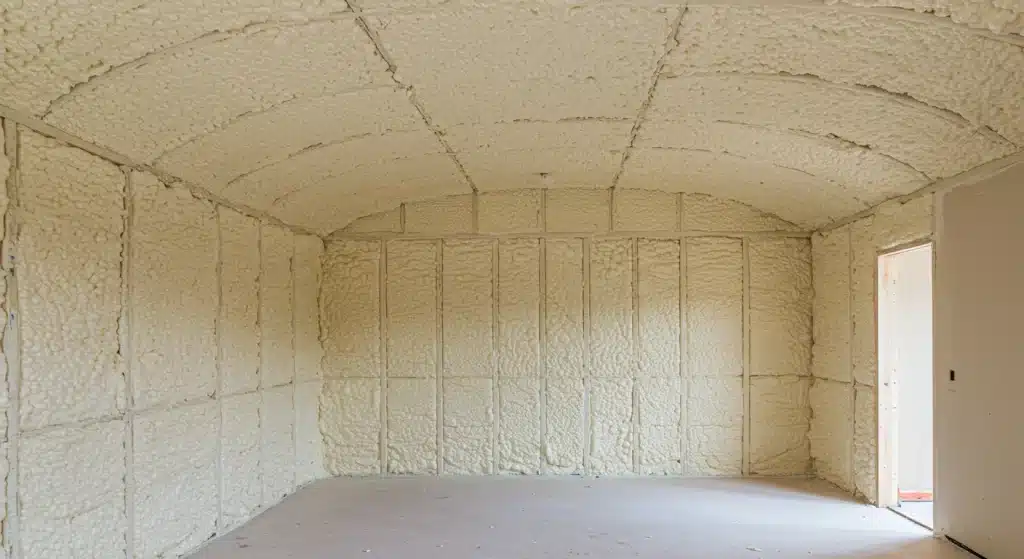Properly installed spray foam insulation is one of the most effective ways to reduce indoor allergens because it creates a near-impenetrable air barrier. Unlike traditional insulation, spray foam expands to fill every crack, gap, and crevice in a building’s envelope. This stops unfiltered air, along with the pollen, dust, and pollutants it carries, from entering the home. The result is a controlled indoor environment where air quality can be managed far more effectively.
This airtight seal is the primary defense against common outdoor allergens. But the benefits don’t stop there. Spray foam also helps control moisture, which is critical for preventing the growth of mold and mildew, two major indoor allergen sources. This guide explains the mechanics behind how professionally applied spray foam works to create a healthier living space, based on extensive field experience in residential and commercial properties.
How Spray Foam Creates an Allergen Barrier
The key to spray foam’s effectiveness lies in its ability to stop air leakage. The U.S. Department of Energy reports that air leaks are a major source of energy loss and can introduce outdoor pollutants into a home. When spray polyurethane foam (SPF) is applied, it starts as a liquid and expands up to 100 times its original volume, hardening into a solid, continuous layer of insulation.
This process achieves several things at once:
- It seals micro-openings: Tiny gaps around window frames, plumbing penetrations, and electrical outlets are completely sealed.
- It forms a monolithic barrier: There are no seams or joints for air to pass through, unlike with fiberglass batts or loose-fill cellulose.
- It adds structural integrity: The rigid nature of closed-cell spray foam can strengthen the wall assembly, reducing flexing that might create new cracks over time.
By creating such a tight building envelope, the home’s heating, ventilation, and air conditioning (HVAC) system can function as intended. The air you breathe is the air that has passed through the system’s filter, not air that has seeped in through a dusty attic or crawlspace.
The Link Between Moisture Control and Mold Prevention
Moisture is the primary ingredient needed for mold to grow. According to the Environmental Protection Agency (EPA), controlling moisture is the most effective way to prevent indoor mold growth. Mold spores are a powerful allergen and irritant for many people.
Closed-cell spray foam acts as a vapor barrier, preventing moisture-laden air from passing through the walls and condensing on cooler surfaces inside the wall cavity. This is particularly important in climates with high humidity or significant temperature differences between the indoors and outdoors. By keeping building materials dry, spray foam directly inhibits the growth of mold and mildew.
Bonus Tip: Even with a well-sealed home, it’s good practice to run exhaust fans in bathrooms and kitchens for at least 20 minutes after use. This helps vent moisture generated inside the home, maintaining optimal indoor humidity levels.
Comparing Insulation Types for Allergen Control
Not all insulation materials offer the same level of protection against allergens. The primary differences lie in their ability to seal against air movement and resist moisture.
| Feature | Spray Foam Insulation | Fiberglass Insulation | Cellulose Insulation |
|---|---|---|---|
| Air Sealing | Excellent; creates a complete air barrier. | Poor; allows significant air movement through and around batts. | Moderate; settles over time, creating gaps. |
| Moisture Resistance | Excellent; closed-cell foam is waterproof. | Poor; can absorb moisture, promoting mold growth if it gets wet. | Poor; absorbs moisture easily, though treatment can add some resistance. |
| Allergen Resistance | Excellent; inorganic material does not support mold growth. | Moderate; inorganic, but can trap dust and moisture, allowing mold to grow on the trapped material. | Poor; made from organic paper material that can support mold growth if it becomes damp. |
| Pest Resistance | Excellent; it creates a solid barrier that pests cannot easily chew through or nest in. | Poor; pests like rodents and insects can easily nest within fiberglass batts. | Moderate; treated with borates, which can deter pests, but it is not a physical barrier. |
Things to Consider Before Making a Decision
Choosing to install spray foam is a significant investment in your property and your health. Before moving forward, it’s important to evaluate a few factors to ensure the best outcome.
Existing HVAC System
Because spray foam creates a very tight home, your HVAC system’s performance may change. In some cases, a home can be sealed so effectively that mechanical ventilation, such as a Heat Recovery Ventilator (HRV) or Energy Recovery Ventilator (ERV), may be needed to ensure a steady supply of fresh, filtered air. An HVAC professional can assess your system’s capacity.
Type of Spray Foam
There are two main types of spray foam:
- Open-Cell SPF: Has a spongy, flexible texture and is an excellent air barrier and sound-dampening agent. It is permeable to vapor, so it may require a separate vapor barrier in some climates.
- Closed-Cell SPF: Is rigid, dense, and acts as an all-in-one air, vapor, and water barrier. It also has a higher R-value per inch, making it a more powerful insulator. For allergen and moisture control, closed-cell is generally the superior option.
The Importance of Professional Installation
This is perhaps the most important factor. The performance of spray foam insulation is entirely dependent on its installation. The chemical components must be mixed at the correct ratio and temperature. Information from the Spray Polyurethane Foam Alliance (SPFA) highlights that trained professionals are essential for a safe and effective application. An improper installation can lead to poor performance and even lingering chemical odors.
Bonus Tip: Before hiring a contractor, ask for proof of certification and training from organizations like the SPFA. Experienced installers will also know how to properly ventilate the area during and after application to ensure a safe and complete cure.

FAQS
Can spray foam eliminate all allergens?
No insulation can eliminate all indoor allergens. Sources like pets, indoor plants, and dust mites will still exist. However, spray foam drastically reduces the number of external allergens entering the home, giving you much greater control over your indoor air quality.
Is spray foam safe for people with chemical sensitivities?
Once fully cured, spray foam is inert and stable. It does not release gases or chemicals. The installation process, however, does involve chemical reactions that produce fumes. Individuals with sensitivities should vacate the premises during application and for a recommended period afterward, typically 24-48 hours, to allow for complete curing and ventilation.
Does spray foam help with noise reduction too?
Yes, it does. The same properties that block airflow also help to dampen sound waves. Open-cell foam, in particular, is very effective at reducing airborne noise, contributing to a quieter and more peaceful indoor environment.
How long does it take for spray foam to cure?
Spray foam is typically tack-free within minutes, but a full cure takes longer. Most manufacturers recommend staying out of the home for at least 24 hours after application is complete to ensure the chemical reaction has finished and the area has been thoroughly ventilated.
Creating a Healthier Indoor Space
Properly installed spray foam insulation serves as a foundational element in creating a home with better indoor air quality. By forming a complete air and moisture barrier, it directly combats the infiltration of common allergens like pollen, dust, and mold spores.
The decision to use spray foam should be based on an evaluation of your home’s specific needs, your long-term health goals, and a commitment to professional installation. When done correctly, it is a lasting improvement that supports a cleaner, healthier, and more comfortable living environment.
Get a Professional Assessment
Understanding your home’s unique air sealing needs is the first step toward reducing indoor allergens. For a detailed evaluation and to discuss if spray foam is the right solution for your property, contact the team at Supreme Spray Foam LV. You can reach the office by calling (702) 904-9895 or by sending an email to [email protected] to schedule a consultation. An experienced technician can help you identify sources of air leakage and create a plan for a healthier home.
Sources
- U.S. Department of Energy – Provides official information on the importance of air sealing for energy efficiency and indoor air quality.
- Environmental Protection Agency (EPA) – Offers comprehensive guidance on mold prevention and the critical role of moisture control in homes.
- Spray Polyurethane Foam Alliance (SPFA) – An industry organization that provides authoritative information on the safe and effective installation of spray foam insulation.






